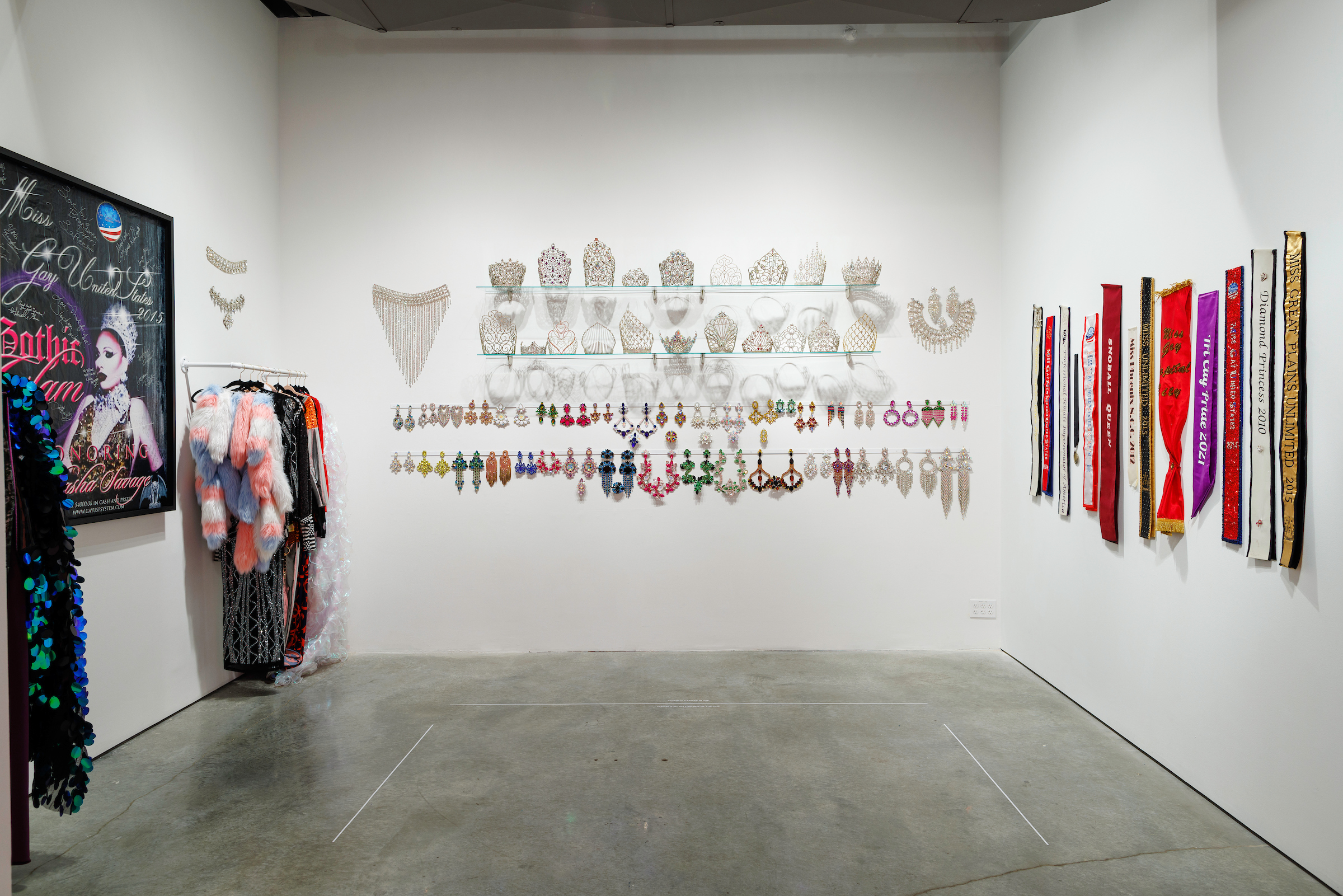If you were to free-associate the word “opulence” you might generate images of baroque architecture, sumptuous gowns, and jewelry, and, if you have a finger on the pulse of queer culture, perhaps drag queens and underground nightlife. But the midwest and its sprawling corn fields don’t come to mind. Invoking great affluence and luxurious lifestyles, opulence is most readily tethered to cosmopolitan, urban environments.
While curating the exhibition, Opulence: Performative Wealth and the Failed American Dream, currently on display at the Bemis Center for Contemporary Arts in Omaha, NE, I assembled eight artists whose work with opulent aesthetics examines how America’s obsession with wealth and its presentation shapes class, race, and gender. In a capitalist society where ‘good taste’ often signals class affiliations, status, and power and consumerism peddles materialism as self-realization, marginalized communities are forced to contend with the false promise of the American Dream. By toying with notions of high and low culture, the works in this exhibition employ aesthetics of decadence to critique how, despite America’s pledge of equal access to prosperity, systemic barriers deny some communities opportunity and restrict social mobility.
Two of the exhibiting artists, Faleasha Savage, an entertainer celebrated in the drag pageant world, and Imagine Uhlenbrock, a successful nail artist, represent practices that are not typically showcased in contemporary art spaces. As Nebraska natives, their lives, careers, and artistry embody the ideas in Opulence from a unique, midwestern perspective. I had a conversation with them to understand how the aesthetics of opulence shapes identity and community in a decidedly unglamorous, agrarian, meat-packing state.
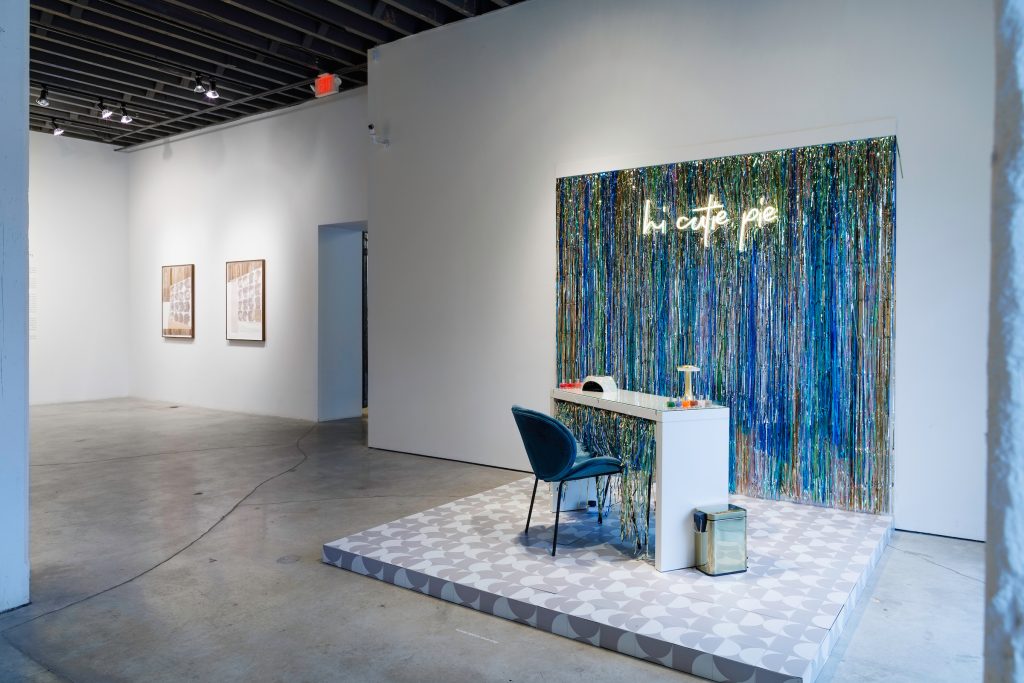
Jared Packard: Can you tell us a bit about the context you grew up in?
Faleasha Savage: I grew up all over western Nebraska. I didn’t really go to an elementary school for more than a year because we were always moving. My parents split and we didn’t really stabilize until about middle school. That’s when I started school in Grand Island, Nebraska. I got into some trouble and ended up in a group home. I was in the Masonic-Eastern Star Home for Children for a couple of years before my mom was able to get me out when I was sixteen. There wasn’t really much exposure to anything other than farm life. Lots of sticks and dirt and cows.
Imagine Uhlenbrock: I was born and raised in Omaha, Nebraska. My mom is from here and my dad is from Mississippi. Both of my parents are artists in their own ways and I was always into making things. Growing up, I didn’t seem to have the same limitations that keep other people boxed into what we consider ‘normal’ or ‘regular,’ so I was always going to be a little bit extra. My great-grandma was the one who taught me acts of self-care: how to file my own nails, and how to crochet. We’d watch Wheel of Fortune and drink Shasta.
JP: What are some of your earliest experiences or inclinations towards opulent and fabulous aesthetics?
FS: When I was in high school in Grand Island there was this store in the mall called Gadzooks. It was like a more trendy Hot Topic. My manager’s name was Manny. I call him my “gay mother goose” because he was the first openly gay person I had ever met. He introduced me to drag queens and took me to drag shows. But back then I wasn’t old enough to go to bars. Out in Grand Island, they used to throw parties in a barn. They had converted it into a makeshift dance floor and hosted parties like twice a year out in the middle of nowhere because there wasn’t anywhere else safe to go.
IU: I’ve painted my own nails since I was four years old. Then in middle school, I saw some nail art and I was like “oh I can do that.” It was grounding—a very physical form of art. When you are doing your own nails, you are paying complete attention to yourself since you can’t really do much else during the process. Right now, I’m wearing long silver chrome nails when I could just have a fingertip-length French. I think that was also something that I leaned into during adolescence, too. If I’m going to be considered weird, I’m just going to go all the way with it. If I have to be perceived at all, you’re going to see me.
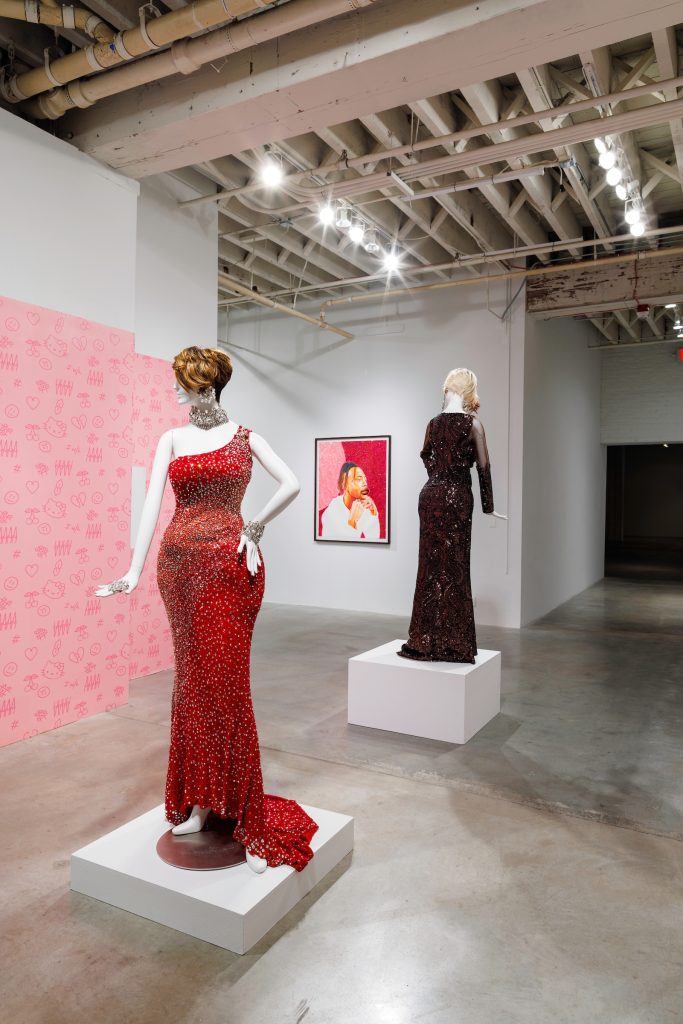
JP: That’s really interesting. If you’re already visible, you may as well be hypervisible?
IU: Well, you’re already hypervisible within blackness, especially in a very segregated city like Omaha. When you go out of your zone, you are sticking out like a sore thumb. I think it’s kind of a reclamation. If you are going to get stared at, it’s deciding for yourself how you are going to show up in that space and how you’re going to navigate it.
JP: Do you recall your first encounter with opulence?
FS: I graduated high school early… when I was seventeen. From there, I immediately moved to Atlanta. I had a fake ID so I was able to go out to the bars. One time, we were out there dancing and all of a sudden they made everyone move. I’m like, “What’s happening?” And then this woman was being lowered from the ceiling. That was the first time I saw a queen perform. I was mesmerized. As I watched her being lowered, something clicked in my head. I was like, “That’s a queeeeeeeen…so this is what it’s like compared to dancing in a barn.” It was very different for me. There was money being thrown and lights everywhere. It was very intense.
IU: As a kid, all these ideas that we are calling opulent and fabulous were looked at as simply weird. Now as adults, we have better terminology for it. Growing up in the city with a very open-minded mom, surrounded by artists it’s hard to pinpoint exactly when I first encountered opulence. Looking back at childhood photos you can see I always had some flair to my style. Even if I didn’t exactly see opulence I was given the space and freedom to embody whatever naturally came to me. A lot of the pushback that I’ve received in my self-expression has been from people who’ve not been allowed that same freedom. My style can be polarizing some people see it as an inspiration and for others, it brings up all their unprocessed emotions almost like ‘who is this Black Nebraska girl loving herself?”’
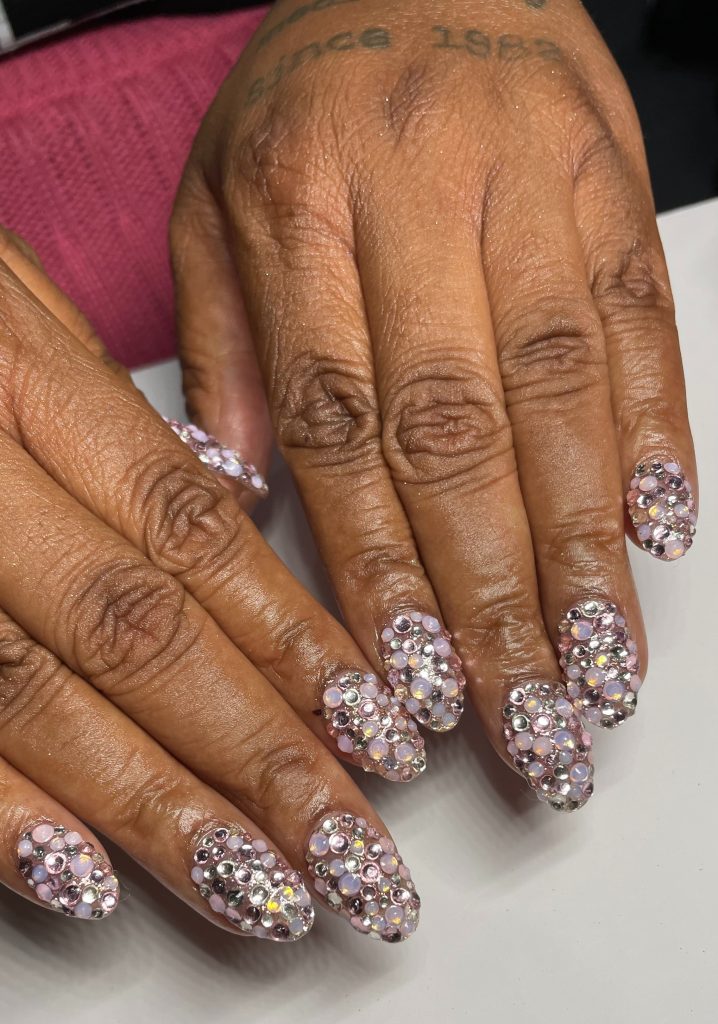
JP: How do people receive your artistry? Faleasha, for you that might be people watching you in the audience. Imagine, that might mean your clients who wear your nail art.
IU: My clientele has always been a super interesting and broad group of people. Most of them are doing what they can to be socially aware, kind, and conscientious of what’s going on with the people around them. And they are extending that same level of care to themselves. So for them, it’s like a new way to explore their identity. Who are they going to be for the next two weeks? Depending on what color you get, you might change how you dress, or maybe you have a new favorite shirt and you want to base your nails off of that. I think that’s a very important thing about where we are at in the world right now, figuring out how to have fun.
FS: I want my audience to experience what I experienced in Atlanta that very first time I saw that queen coming down from that ceiling. That’s what I want to bring to the stage. I want to make sure that everything on stage is covered in rhinestones or something sparkly. I don’t want to look cheap when I go out on stage. The goal is to always look as expensive as you can.
JP: How has your investment in this aesthetic or lifestyle formed your relationship to the community?
FS: I am actually the first house in Nebraska. My first child was Nina Savage and then I took on Chanelle and Alexis. In the beginning, most people didn’t understand it. People would give them flack and say they were riding my coattails. I am there for them 24/7 no matter what they need. We just all happen to do drag. Some of my drag kids don’t even have family anymore. Either not here on earth anymore or literally being asked to leave home. So you create a drag family so you have a sense of unity and support. You make a chosen family.
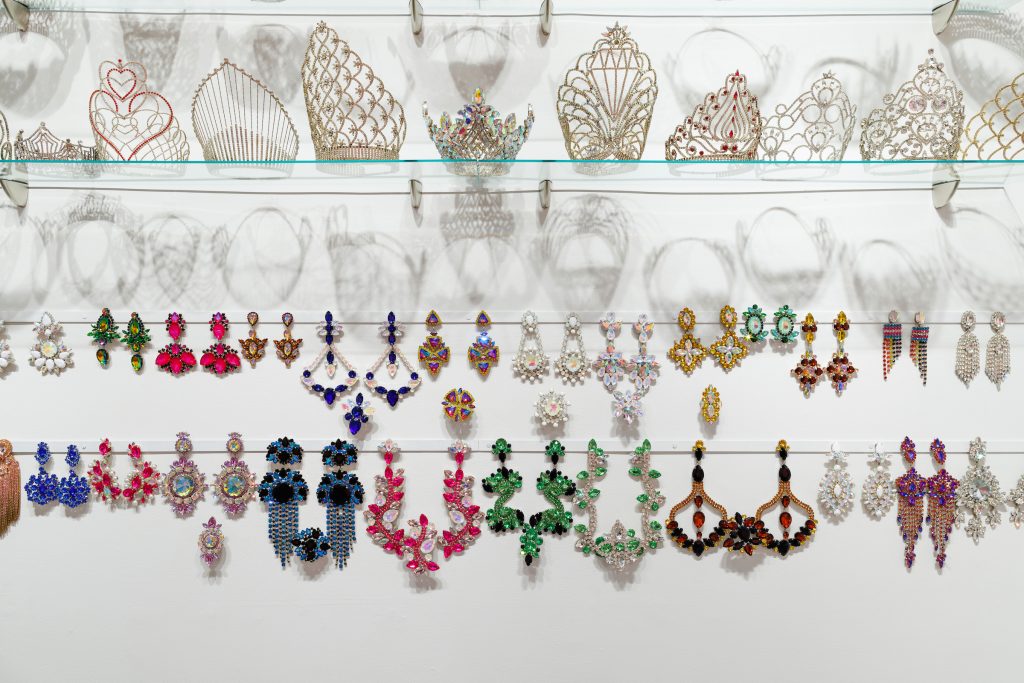
JP: Did you have an experience like that when you came out?
FS: When I came out as gay, I got a little bit of flack from my mom’s side. But when I came out as trans, they were like, “Oh, that makes all the sense in the world!” and they were supportive again.
JP: Imagine, what about you? How does getting your nails done impact how you relate to others?
IU: When you look good, you feel good. And by getting your nails done by somebody else it turns that self-care into a form of community care. The further you are on the racial spectrum from whiteness, the more physical expectations there are of you and how you show up in femininity. The other day, one of my good friends made a TikTok about how she feels like she has to wear makeup just to go to the corner store or she’s going to be treated like a suspect. I’ve never heard a white person talk like that. And I think nail art can be a kind of defiance. Anything that looks like you’re asserting your autonomy, people take offense to. Also, I think resistance to certain aesthetics can be very white.
JP: As a non-native Nebraskan, I’ve noticed a distinctly Midwestern sense of initiative and do-it-yourself spirit that, I think, is a product of not having the same access to resources that artists in more urban settings can find easily.
FS: Absolutely. You definitely don’t have the same options here that you’d have compared to when I lived in Atlanta or Arizona. Things that were at your fingertips are definitely not possible here… especially when it comes to clothing designers and hairstylists. Starting out, I didn’t know anything. I used to make everything out of hot glue or I would go to Goodwill and cut up some fabric and safety pin it into something fabulous. I had a roommate who did dress alterations and she taught me how to sew. That really pushed me to learn more. In the Midwest, it’s fight or flight. Like, “Are you gonna fight for this? Or give up?”
IU: Well, yeah. I think for a lot of people who have that “I have to do it for myself” mindset, taking the time to get your nails done by somebody else is a very conscious decision to let someone do something for you. A lot of the time, they’re going to make it a priority to share that level of care with someone else. By getting your nails done on a regular basis or any other service that enhances your appearance or facilitates that personal expression, it starts to trickle into other areas of your life.
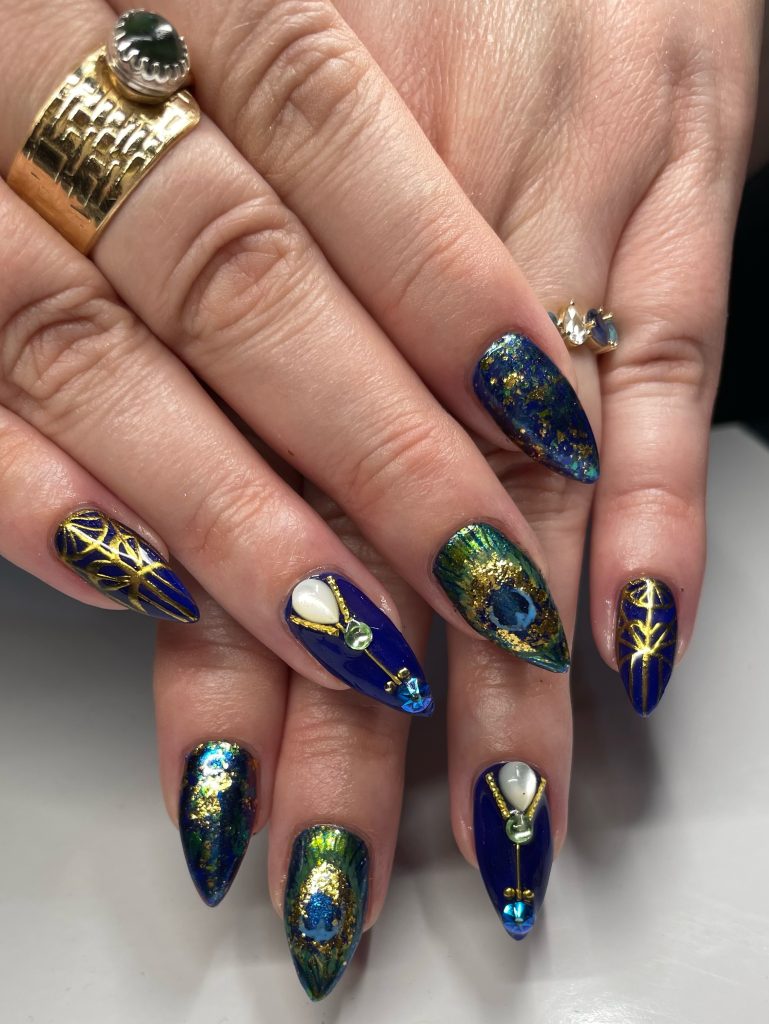
JP: How has your relationship to the aesthetics we’ve talked about shaped you?
FS: I don’t know if I would have ever realized I was trans if I hadn’t been exposed to drag. Being exposed to that exposed me to this whole other world I had no idea existed. I think by allowing myself to be creative and pushing myself to learn more really has molded me into what I am today. When I was younger, I would never speak out about controversial things. But now I call out people that I don’t agree with. I use my social media platform to make people aware of injustices happening around us and encourage people to stand up for themselves.
IU: I’ve learned not to save feeling fabulous for a special occasion; it shouldn’t be a luxury. If that’s who you are, just do it. You can make it a daily, weekly, or monthly practice. You should get to feel good about yourself on a regular basis. It should be a comfortable experience. I remember doing nails for someone and they were like, “wow my nails don’t hurt,” That’s not good if every experience of beauty before this was painful. That says a lot about other areas of life. People expect pain, people think love and truth should hurt. None of them should hurt. Beauty and good times should not be a luxury.
Faleasha Savage (legal name: Erin Sundberg) grew up in Western Nebraska and is an Omaha-based entertainer. A gifted performer and vocal trans rights activist, Savage has left her mark on the United States drag pageant scene and holds five national titles and over forty regional, state, city, and bar titles.
Imagine Uhlenbrock is an Omaha-based nail artist and business owner acclaimed for her intricate nail portraiture, themed sets of nails, and her ability to draw inspiration from fabric patterns and fine art. In her over ten years as a freelance nail artist, she has cultivated a dedicated clientele who return time and again not only for Uhlenbrock’s skill and artistry, but also to enjoy a moment of self care. Uhlenbrock’s business, Just Imagine Nails, provides the community with an opportunity for self-expression as her clients sometimes sport extravagant nails that make political statements or convey personal narratives.
Opulence: Performative Wealth and the Failed American Dream is on display at the Bemis Center for Contemporary Arts, Omaha, NE through April 16, 2023. Transcription assistance provided by Hana Brock and Marco Delgado
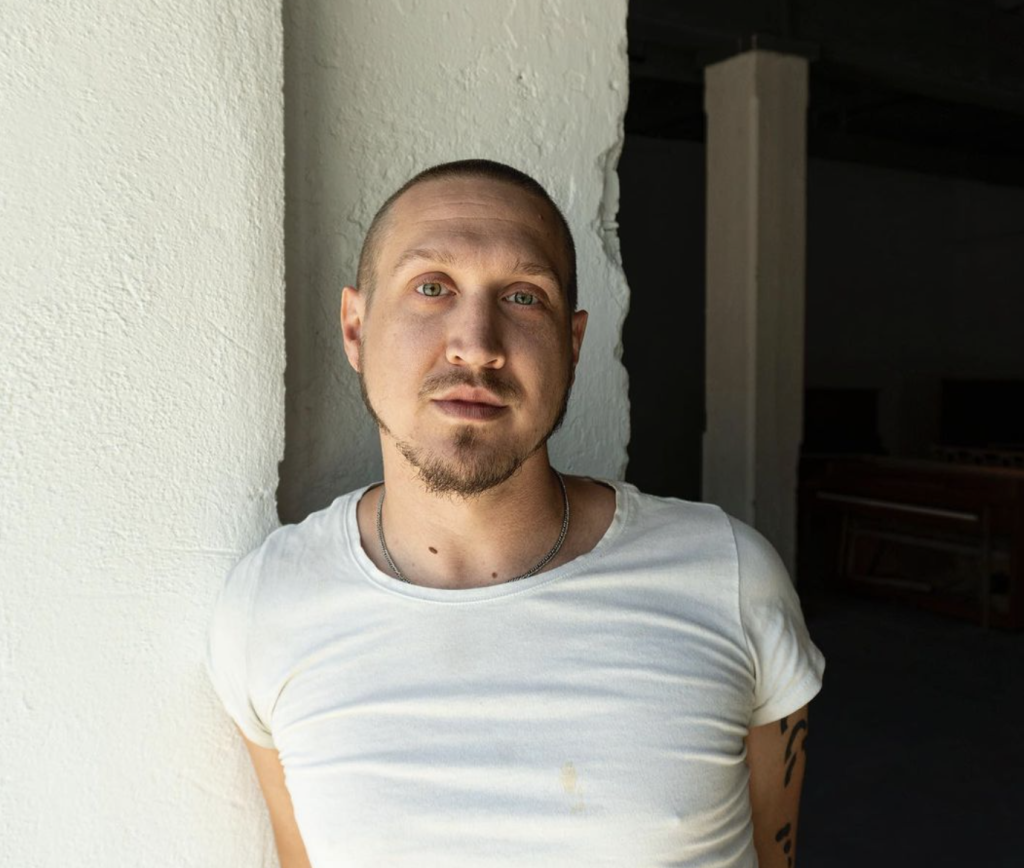
About the Author: Jared Packard (b. 1989) is an artist and curator based in Omaha, NE. Packard completed his BA at Clark University and his MFA at School of the Art Institute of Chicago. He is currently the Exhibitions Manager at the Bemis Center for Contemporary Art where he curated ‘Opulence: Performative Wealth and the Failed American Dream.‘
